异常处理参考答案
品质异常处理流程试题(附答案)

品质异常处理流程试题姓名: 部门:得分:一、填空题(每小题4分,共60分)1、不合格品处理程序中品管部的职责:负责对、、检验过程中发现的不合格品进行判定、标示、隔离及记录。
2、仓库在来料收货和存储过程中发现的不合格品,应通知和对该物料进行识别。
3、物料、制程中半成品及成品不合格品的标识按的规定进行。
4、凡经制造部生产线操作人员和测试员检验发现的不合格半成品,由在《检验日报表》中予以记录。
5、不合格物料应由部主管确认检验结果的准确性。
6、不合格品超出允收范围的不合格物料批次,由填写《IQC REJ通知书》通知作相应处理。
7、不合格物料如因生产或货期急需,由采购部提出申请并经IQC确认后,召开会议,按会议决定执行。
8、采购在发出《供应商品质异常联络书》后,应限定其在个工作日内将其发回本公司,在此期间,采购必须对所发出的《供应商品质异常联络书》进行追踪。
9、作业过程中出现或检查出批量不合格时,由生产线领班、测试员领班或IPQC领班发出,并通知制造部,防止继续生产不合格品。
10、QA检验发现的不合格品,需经QA领班、IPQC领班、制造部领班三方共同确认后将结果记录于并发出《不符合及改善对策报告》,由相关部门对发现的问题进行分析,并在个工作日内回复。
二、简答题(每小题10分,共40分)1、制程中的不合格半成品如何进行识别?2、简述不合格物料、不合格半成品和不合格成品的隔离方法。
3、简述不合格物料的处理流程。
4、简述不合格成品的处理流程。
《不合格品处理程序》试题一、填空题(每小题4分,共60分)1、进料、制程、成品2、采购,IQC3、《产品标识与可追溯性控制程序》4、制造部领班5、品管6、品管部IQC,采购7、MRB8、59、《不符合及改善对策报告》10、《QA检验报告》,3二、简答题(每小题10分,共40分)1、制程中的不合格半成品如何进行识别?答:制程中的半成品不合格,由操作人员、测试员和IPQC依据《产品的测量和监控程序》和《作业指导书》以及样品,通过自检、巡检或专检进行识别。
异常判定标准与处理试题

异常判定标准与处理试题1、异常处理时效为()A、48HB、24H(正确答案)C、12HD、6H2、()负责原材料进料检验,达到异常标准作判退,并反馈SQE处理A、生管B、SQEC、IQC(正确答案)D、仓库3、()负责原材异常处理,追踪供应商有效改善A、生管B、SQE(正确答案)C、IQCD、仓库4、一个时间段为几个小时()A、2H(正确答案)B、1HC、4HD、5H5、X-RAY不良有()即停线B、1PCS(正确答案)C、2PCSD、4%6、裂片站不良()即启动异常A、1%B、2%(正确答案)C、2PCSD、3PCS7、SPI站()即启动异常机制A、1%B、2%C、2PCS(正确答案)D、3PCS8、()负责协助调查发生原因及执行有效改善方案A、制造(正确答案)B、工程C、生管D、品质9、()负责质量单位开出的异常单进行分析A 生管B 工程(正确答案)D 仓库10、()负责异常造成停线影响到出货并及时应对出货计划调整A 生管(正确答案)B 工程C 品管D 仓库11、SPI站同一位置同一时间段同一不良现象()启动异常A、3PCS(正确答案)B、1%(正确答案)C、5%D、0.5%12、AOI可以检测哪些不良现象()A、少锡(正确答案)B、空焊(正确答案)C、短路(正确答案)D、漏贴标签13、如下哪种情况会造成异常()A、机器当机无法生产B、生产/测试治工具未进行首件确认(正确答案)C、良品与不良品未区分(正确答案)14、如下哪些属于十大禁止()A、禁止不扫描上料(正确答案)B、禁止挪料生产(正确答案)C、禁止测试不看画面(正确答案)D、禁止测A扫B(正确答案)15、如下哪种情况会造成停线()A、人员未依静电防护作业B、测试程序版本错误(正确答案)C、OQC同一种不良发现两次(正确答案)D、人力不足16、哪些站别达到3%需要停线()A、SPI(正确答案)B、AOI(正确答案)C、目检(正确答案)D、总检(正确答案)17、下面哪项属于异常()A、人员未做静电防护(正确答案)B、生产测试工具未进行首件测试(正确答案)C、仪器未校验或未依规定进行日常保养D、其它的一些物体当住传感器18、下面哪项属于停线()A、良品不良品未区分B、未做首件检查(正确答案)C、锡膏未按管制要求使用(正确答案)D、人力不够19、下面哪项是异常开立基准()A、同一时间段不良达到1%(正确答案)B、IPQC稽核缺失C、6S稽核缺失D、同一时间段连续发生3PCS(正确答案)20、下面哪项是重大异常开立基准()A、缺件(正确答案)B、错料(正确答案)C、批量异常(正确答案)D、反向(正确答案)21、产线停线时间超过30分钟,钢板上锡膏回收搅拌后方可上线使用对(正确答案)错22、不良品返工/返修需按标准流程作业,自检合格后须重新经品质复检后方可流入下一工对(正确答案)错23、ABL启动后,需要填写异常单或者停线通知单,反馈责任单位分析改善对错(正确答案)24、任何异常都需要做风险评估,并填写风险评估报告对错(正确答案)25、ABL启动后,需针对风险批产品进行HOLD,通知责任单位分析及改善,并追踪重工结果对(正确答案)错26、不管什么异常,都属于重大异常对错(正确答案)27、工程部:负责对设计不良或产品标准不明确的整改制订纠正与预防措施;对制造不良的纠正与预防措施给予技术支持对(正确答案)错28、品质部:负责对发现或反馈来的产品品质异常进行检验判定、品质异常时的处理协调、不合格品的处置跟进,纠正与预防整改效果的验证、不合格信息传递与跟进等对(正确答案)错29、为产品有缺陷避免争议所制定对(正确答案)错30、目的:为了规范、及时、高效地处理制程品质异常问题,保障制程产品品质,特制订本标准对(正确答案)错31、产线风险批应为制造领班组长评估对错(正确答案)32、产线异常应为生管开立对错(正确答案)33、SPC是统计制程管理对(正确答案)错34、超过3spc管制范围属于异常对(正确答案)错35、OQC同一批批退一次属于异常对错(正确答案)36、SOP规定错误料号规格等属于异常对(正确答案)错37、测试连续3片同一问题为异常,连续5片以上停线对(正确答案)错38、材料辅材超过使用期限属于异常对错(正确答案)39、机器参数设定错误属于停线对(正确答案)错40、人力无法满足开线属于异常对错(正确答案)。
5.11疑似异常反应监测与处置参考答案
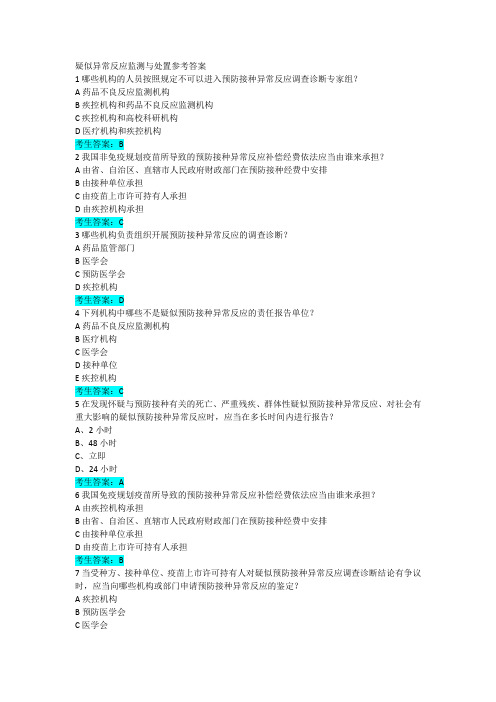
疑似异常反应监测与处置参考答案1哪些机构的人员按照规定不可以进入预防接种异常反应调查诊断专家组?A药品不良反应监测机构B疾控机构和药品不良反应监测机构C疾控机构和高校科研机构D医疗机构和疾控机构考生答案:B2我国非免疫规划疫苗所导致的预防接种异常反应补偿经费依法应当由谁来承担?A由省、自治区、直辖市人民政府财政部门在预防接种经费中安排B由接种单位承担C由疫苗上市许可持有人承担D由疾控机构承担考生答案:C3哪些机构负责组织开展预防接种异常反应的调查诊断?A药品监管部门B医学会C预防医学会D疾控机构考生答案:D4下列机构中哪些不是疑似预防接种异常反应的责任报告单位?A药品不良反应监测机构B医疗机构C医学会D接种单位E疾控机构考生答案:C5在发现怀疑与预防接种有关的死亡、严重残疾、群体性疑似预防接种异常反应、对社会有重大影响的疑似预防接种异常反应时,应当在多长时间内进行报告?A、2小时B、48小时C、立即D、24小时考生答案:A6我国免疫规划疫苗所导致的预防接种异常反应补偿经费依法应当由谁来承担?A由疾控机构承担B由省、自治区、直辖市人民政府财政部门在预防接种经费中安排C由接种单位承担D由疫苗上市许可持有人承担考生答案:B7当受种方、接种单位、疫苗上市许可持有人对疑似预防接种异常反应调查诊断结论有争议时,应当向哪些机构或部门申请预防接种异常反应的鉴定?A疾控机构B预防医学会C医学会D药品监管部门考生答案:C8按照疫苗管理法规定,国家加强预防接种异常反应监测,预防接种异常反应监测方案由哪些部门制定?A国务院卫生健康主管部门会同国务院药品监督管理部门制定B国务院药品监督管理部门制定C国务院卫生健康主管部门制定考生答案:A9在下列怀疑因预防接种导致受种者损害的情形中,哪些应当是由设区的市级以上人民政府卫生健康主管部门、药品监督管理部门按照各自职责组织调查、处理的?A非严重事件B群体性疑似预防接种异常反应C严重残疾D死亡E其他对社会有重大影响的疑似预防接种异常反应考生答案:B,C,D,E10下列哪些情形属于严重的疑似预防接种异常反应?A需住院治疗或者延长已在住院治疗的时间B持续的或者显著的人体伤残/失能C死亡D危及生命考生答案:A,B,C,D11下列哪些情形应当由设区的市或者省级预防接种异常反应调查诊断专家组进行调查诊断?A群体性疑似预防接种异常反应B受种者死亡C受种者严重残疾D对社会有重大影响的疑似预防接种异常反应考生答案:A,B,C,D12疑似预防接种异常反应是指在预防接种后发生的与预防接种有关的反应或事件。
项目9 异常处理.-习题答案

习题答案一、选择题1.以下保留字不用于异常处理逻辑的是( A)A.ifB.elseC.tryD.finally2.以下关于Python语言中try语句的描述中,错误是(B)A. 当执行try代码块触发异常后,会执行except后面的语句B. try用来捕捉执行代码发生的异常,处理异常后能够回到异常处继续执行C. try代码块不触发异常时,不会执行except后面的语句D. 一个try代码块可以对应多个处理异常的except代码块3.哪一个类是所有异常类的父类( C)。
A. TypeErrorB. ErrorC. ExceptionD. BaseException4. 在Python异常处理机制中,(C)子句的代码是无论是否有异常都要执行。
A. IfB. elseC. finallyD. Except5.在完整的异常语句中,语句出现的顺序正确的是(D)A.try->except->finally->elseB.try->else->finally->exceptC.try->finally->else->exceptD.try->except->else->finally二、编程题1. 编写程序通过raise引发一个ZeroDivisionError异常,捕获后输出“捕获到ZeroDivisionError”。
参考答案:try:raise ZeroDivisionErrorexcept ZeroDivisionError:print("捕获到ZeroDivisionError")2.编写程序,按照用户输入的边长计算正方形的面积,若边长为负值则抛出异常(正方形的面积公式:S=a*a)参考答案:def get_width():width = int(input("请输入正方形边长:"))assert width>=0 ,"输入的边长不符合规范"return widthdef cal_area():width = get_width()return width*widthdef show_are():try:print("执行show_area()方法")square_area = cal_area()print(f"正方形的面积是:{square_area}")print("正方形面积计算完成")except Exception as err:print(f"捕获到异常:{err}")show_are()3.编写程序实现对学生的Python课程期末成绩进行等级评定,大于等于90分的为“优秀”,80分到90分的(包括80分)的为“良好”,60分到80分的(包括60分)为“合格”,60分以下为“不合格”,最有把学生成绩打印出来。
品质异常处理流程试题答案
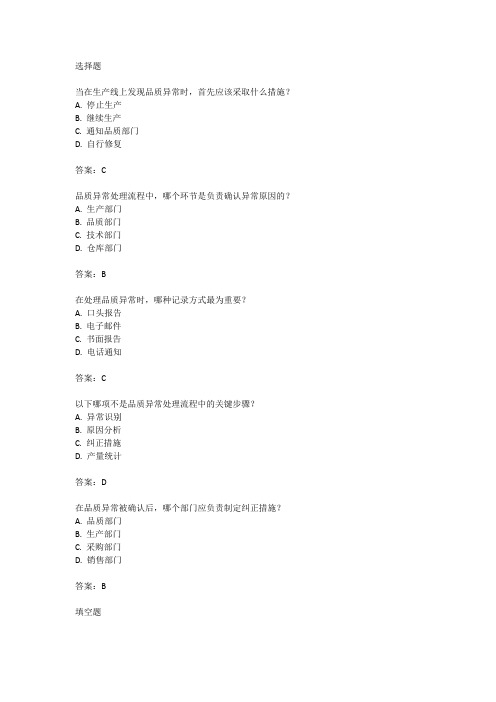
选择题当在生产线上发现品质异常时,首先应该采取什么措施?A. 停止生产B. 继续生产C. 通知品质部门D. 自行修复答案:C品质异常处理流程中,哪个环节是负责确认异常原因的?A. 生产部门B. 品质部门C. 技术部门D. 仓库部门答案:B在处理品质异常时,哪种记录方式最为重要?A. 口头报告B. 电子邮件C. 书面报告D. 电话通知答案:C以下哪项不是品质异常处理流程中的关键步骤?A. 异常识别B. 原因分析C. 纠正措施D. 产量统计答案:D在品质异常被确认后,哪个部门应负责制定纠正措施?A. 品质部门B. 生产部门C. 采购部门D. 销售部门答案:B填空题品质异常处理流程的第一步是_______ 异常。
答案:识别在品质异常处理中,_______ 分析是确定问题根源的关键步骤。
答案:原因品质异常处理完毕后,需要编写_______ 报告以记录处理过程和结果。
答案:品质异常处理品质异常处理流程中,_______ 措施的实施是为了防止异常再次发生。
答案:纠正与预防对于重大品质异常,通常需要组织_______ 会议来讨论解决方案。
答案:专题或专项品质异常处理流程要求相关人员保持_______ ,确保信息准确传递。
答案:沟通畅通简答题简述品质异常处理流程的主要步骤。
答案:品质异常处理流程的主要步骤包括:识别品质异常、报告并记录异常、分析异常原因、制定纠正措施、实施纠正措施、验证纠正效果、预防措施的制定与实施、总结与反馈。
在品质异常处理中,为什么原因分析非常重要?答案:原因分析在品质异常处理中非常重要,因为只有准确找出异常发生的原因,才能制定有效的纠正措施,防止问题再次发生。
同时,原因分析也有助于提升生产过程的稳定性和产品质量的可靠性。
请描述品质异常处理流程中书面报告的作用。
答案:书面报告在品质异常处理流程中起到了记录、沟通和反馈的作用。
它详细记录了异常发生的情况、原因分析、纠正措施及其实施效果,为相关部门提供了准确的信息,有助于加强内部沟通,促进问题的快速解决,并为后续的品质改进提供数据支持。
java异常处理试题及参考答案

异常处理练习题一、选择题1.java中用来抛出异常的关键字是(C)A、tryB、catchC、throwD、finally2.关于异常,下列说法正确的是(A)A、异常是一种对象B、一旦程序运行,异常将被创建C、为了保证程序运行速度,要尽量避免异常控制D、以上说法都丌对3.(A)类是所有异常类的父类。
A、4.javaA、try{C、5.{{“除0}A、程序将输出第15行的异常信息B、程序第10行出错C、程序将输出“b=42”D、程序将输出第15和19行的异常信息6.下列程序的执行,说法正确的是(D)class ExMulti{static void procedure(){try{int c[]={1};c[42]=99;}catch(ArrayIndexOutOfBoundsException e){“数组超越界限异常:”+e);}}public static void main(String args[]){“除0}ABCD7.{{}{try{procedure();}catch(IllegalAccessExcepton e) ___________{“捕获:”+e);}}8.对于catch子句的排列,下列哪种是正确的(B )A、父类在先,子类在后B、子类在先,父类在后C、有继承关系的异常不能在同一个try程序段内D、先有子类,其他如何排列都无关9.在异常处理中,如释放资源、关闭文件、关闭数据库等由(C )来完成。
A、try子句B、catch子句C、finally子句D、throw子句10.当方法遇到异常又不知如何处理时,下列哪种说法是正确的(C )A、捕获异常B、抛出异常C、声明异常D、嵌套异常11.哪个关键字可以抛出异常?(C)JVM. int i=0;String greetings[]= {“Hello world!”,“No,I mean it!”,“HELLO WORLD!!”};while(i<4){____try________{}____catch__(ArrayIndexOutOfBoundsException e){i=-1;}finally{}i++;}}三、判断题1. ( F )程序中抛出异常时(throw …),只能抛出自己定义的异常对象。
《异常处理管理规定》培训考核试题

《异常处理管理规定》培训考核试题1.当发生哪些异常时需要开停线通知单() [单选题]A.任一款产品综合不良超过 10%,电池盒烧机、自动工作等重缺陷有1例;(正确答案)B.异常对产品的功能有影响,且持续发生,技术部门已给出有效控制方案时;C.制程生产过程中外检岗位发现黑点不良1%;D.在制产品接到市场反馈,确认为一般级客诉,在排查现库存同样存在相同现象时;2.在异常处理时,以下哪项属于品质部的职责() [单选题]A.品质 PQE/QC只要负责异常问题的确认,按照《制程异常反馈单》给相关部门分析,不需要跟踪改善对策的效果确认;B.品质部负责开出异常单,反馈给生技,只要责任部门回复对策就好,不需要验证确认对策的有效性;C.负责异常物料处理以及重大异常发生导致停线时生产排期的重新确认和人员按排。
D.IQC/SQE负责来料异常物料的库存数据排査、隔离、退料,改善物料到料跟进与信息拉通,对供应商进料不良的改善跟踪及效果确认。
(正确答案)3.产线发生异常时是否需要向品质部反馈() [单选题]A.不需要,只需向生技部反馈B.需要(正确答案)C.不需要,可以自己私下处理即可D.以上都有对4.突发异常时以下哪项转线工时是合理的() [单选题]A.(小烟)流水线转线:30分钟(正确答案)B.(雾化芯/器,包装)精益线转线:30分钟C.(电池盒/杆)精益线转线:25分钟D.当异常发生时,PC要求临时排配当天没有计划的机型,物料临时领用的,转线时间 1H。
5.资材部职责是什么() [单选题]A.当发生特急异常与重大异常时以《停线通知单》提报停线,知会生产相关部门;B.负责异常物料处理有重大异常发生导致停线时不需要对生产的排期重新确认和人员安排C.负责异常物料处理以及重大异常发生导致停线时生产排期的重新确认和人员安排(正确答案)D.对工艺结构问题验证改善和ECR申请提出,并进行ECN变更跟进落实。
6.在异常处理时,以下哪项产线做法是正确的() [单选题]A.品质部负责开出异常单,反馈给生技,只要责任部门回复对策就好,不需要验证确认对策的有效性;B.负责异常问题点的反馈,针对问题自身先做排查及纠正;(正确答案)C.NPI/PE负贵对异常原因分析与责任归属的判定及异常造成的损失数据进行审核,所有异常临时处理方案以及制程异常的长期改善对策输出;D.领班负责异常问题点的反馈,针对问题不需要做排查及纠正7.下列哪项是生产部的职责() [单选题]A.异常现象改善措施的实施执行,针对不良品无需返修处理;B.NPI/PE负贵对异常原因分析与责任归属的判定及异常造成的损失数据进行审核,所有异常临时处理方案以及制程异常的长期改善对策输出;C.负责异常问题点的反馈,针对问题自身先做排查及纠正;(正确答案)D.品质 PQE/QC负责异常问题的确认,按照品质标准确认和复判并开出《制程异常反馈单》给相关部门分析,限度样品的制定,改善对策的效果确认和跟踪。
异常处理流程考试试题

一、选择题1.在Java中,使用哪个关键字来捕获异常?A.catch(正确答案)B.tryC.finallyD.throw2.当一个方法可能抛出多种类型的异常时,这些异常类型在方法声明中应该如何指定?A.使用逗号分隔(正确答案)B.使用分号分隔C.使用“或”符号分隔D.使用“与”符号分隔3.在异常处理中,finally块的主要目的是什么?A.捕获异常B.处理异常C.无论是否发生异常都执行代码(正确答案)D.声明可能抛出的异常4.在Java中,如果一个方法可能抛出检查型异常,那么在方法声明时应该使用哪个关键字来声明这些异常?A.catchB.throws(正确答案)C.tryD.finally5.当一个异常被抛出时,Java虚拟机(JVM)会按照什么顺序查找适当的异常处理器?A.从当前方法开始,沿着调用栈向上查找(正确答案)B.从main方法开始,沿着调用栈向下查找C.从当前方法开始,沿着调用栈向下查找D.从main方法开始,沿着调用栈向上查找6.在Java中,自定义异常类通常是从哪个类继承而来的?ng.Objectng.Throwableng.Exception(正确答案)ng.RuntimeException7.在异常处理中,使用哪个关键字可以重新抛出当前捕获的异常?A.catchB.throwsC.throw(正确答案)D.finally8.在Java中,如果一个方法内部抛出了一个未被捕获的检查型异常,那么这个方法应该如何声明?A.无需特别声明B.使用throws关键字声明可能抛出的异常(正确答案)C.使用try-catch块捕获异常D.使用finally块处理异常。
141回jtest参考答案

141回jtest参考答案141回jtest参考答案Jtest是一种常用的软件测试工具,被广泛应用于软件开发过程中。
它可以帮助开发人员发现潜在的错误和缺陷,提高软件的质量和可靠性。
在本文中,我将为大家提供141回Jtest参考答案,帮助大家更好地理解和应用Jtest工具。
1. 异常处理在软件开发过程中,异常处理是非常重要的一环。
通过合理的异常处理,可以避免程序崩溃和数据丢失等问题。
在141回Jtest中,关于异常处理的问题主要涉及以下几个方面:- 异常捕获:在代码中使用try-catch语句来捕获可能抛出的异常,并在catch 块中进行相应的处理。
在编写try-catch语句时,需要考虑到可能的异常类型,并根据具体情况选择合适的处理方式。
- 异常抛出:在方法中可能会抛出异常,需要使用throws关键字声明方法可能抛出的异常类型。
在141回Jtest中,需要注意检查方法的throws声明是否正确,并根据需要进行修正。
- 异常处理的一致性:在代码中,应该保持异常处理的一致性,即相同类型的异常应该有相同的处理方式。
在141回Jtest中,需要检查代码中是否存在异常处理不一致的情况,并进行相应的修改。
2. 边界测试边界测试是一种常用的测试方法,通过测试输入的边界值,可以发现程序中可能存在的错误和缺陷。
在141回Jtest中,边界测试的问题主要涉及以下几个方面:- 上下界测试:对于需要输入范围的参数,需要测试最小值和最大值的情况,以确保程序在边界情况下的正确性。
在编写边界测试用例时,需要考虑到边界值和非边界值的情况,并进行全面的测试。
- 边界条件处理:在边界测试中,需要检查程序对边界条件的处理是否正确。
例如,对于输入范围为1到10的参数,程序应该正确处理输入为1和10的情况,并返回正确的结果。
- 边界值的选择:在进行边界测试时,需要选择合适的边界值。
通常情况下,边界值应该覆盖所有可能的情况,并且应该选择具有代表性的值进行测试。
破解质量工程师异常处理的五大难题课后测试

破解质量工程师异常处理的五大难题课后测试单选题1、现场的特点是“不得不快速反应”,原因是(10分)A不停线恐不良剧增B停线则成本在增、机器在转、作业员在等C停线恐交期受损D以上都是正确答案:D2、当面临停线等现场质量问题,需要QRQC到场时,作为工程师部门经理、生产部门经理,需要在多长时间内到场(10分)A 5分钟之内B 10分钟之内C 20分钟之内D 30分钟之内正确答案:D3、在解决严重质量问题时,综合实战套路——四部曲中的异常“部曲”包括哪些步骤(10分)A出现、确认、界定、描述B排查、围堵、处置、过渡C调查、分析、确定、呈现D拟测、评估、执行、验证正确答案:A多选题4、处理现场质量问题的行动方案有哪些(10分)A排除/隔离B停止生产C停止出货D系统发CAR正确答案:A B C D5、在处理现场质量问题时,QRQC逐级上报规则包括哪些内容(10分)A问题发现区域的生产主管电话通知相关人员。
B如果电话联系不上相关人员,逐级电话通知BRT核心团队成员。
C如果相关人员时间冲突不能到现场,需要指派代理人员到现场。
D如果本人或代理人未在规定时限内到现场,则逐级电话通知BRT核心团队成员,直到有人来到现场参与问题解决。
正确答案:A B C D6、下列关于“客户抱怨与客户忠诚的原理”,说法正确的是(10分)A大约60%的抱怨者,如果他们的问题得到解决,则会继续购买。
B大约40%的抱怨者,完全不会在意问题是否得到解决。
C如果问题的解决速度很快,则继续购买的抱怨者比例可以上升到95%。
D抱怨处理速度要快,则损失能最大幅度地减小。
正确答案:A C D7、在解决严重质量问题时,措施策拟的常用思路和法则是(10分)A措施要基于根因,有针对性B防错是最有力的措施C措施常须横向、纵向展开D Process/MFG主防“发生”,Test/QA主防“流出”正确答案:A B C D8、不良品的处置种类有哪些(10分)A UAI特采B RTV退给供应商C Sorting挑选D Rework返工E Scrap报废正确答案:A B C D E判断题9、在收到客户投诉后,做好初始回应的要求包括快速、全面、清晰和守信,底线是至少符合公司内部规定及与该用户的合同。
异常处理员面试题目及答案
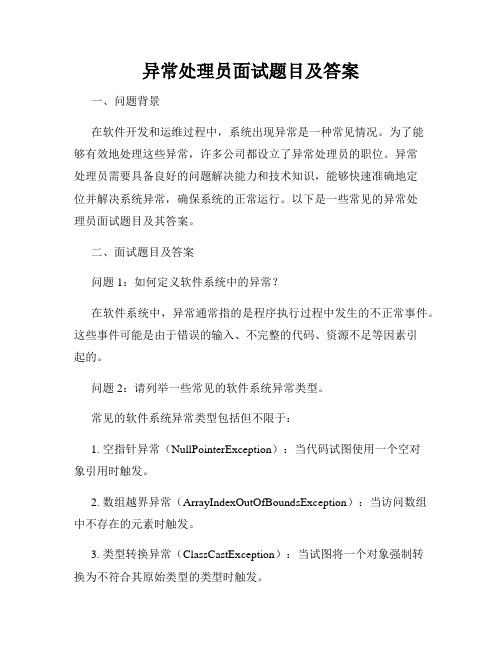
异常处理员面试题目及答案一、问题背景在软件开发和运维过程中,系统出现异常是一种常见情况。
为了能够有效地处理这些异常,许多公司都设立了异常处理员的职位。
异常处理员需要具备良好的问题解决能力和技术知识,能够快速准确地定位并解决系统异常,确保系统的正常运行。
以下是一些常见的异常处理员面试题目及其答案。
二、面试题目及答案问题1:如何定义软件系统中的异常?在软件系统中,异常通常指的是程序执行过程中发生的不正常事件。
这些事件可能是由于错误的输入、不完整的代码、资源不足等因素引起的。
问题2:请列举一些常见的软件系统异常类型。
常见的软件系统异常类型包括但不限于:1. 空指针异常(NullPointerException):当代码试图使用一个空对象引用时触发。
2. 数组越界异常(ArrayIndexOutOfBoundsException):当访问数组中不存在的元素时触发。
3. 类型转换异常(ClassCastException):当试图将一个对象强制转换为不符合其原始类型的类型时触发。
4. 文件不存在异常(FileNotFoundException):当试图打开一个不存在的文件时触发。
5. 数据库连接异常(SQLException):当数据库连接出现问题时触发。
问题3:异常处理的目的是什么?异常处理的主要目的是保证系统的稳定运行和提供更好的用户体验。
通过捕获和处理异常,可以避免系统发生崩溃或异常退出,同时还可以给用户提供有关异常发生的信息和友好的错误提示。
问题4:请简述异常处理的一般流程。
一般而言,异常处理的流程包括以下几个步骤:1. 捕获异常:在可能引发异常的代码块中使用try-catch语句捕获异常。
2. 处理异常:在catch块中对捕获到的异常进行处理,可以输出异常信息、记录日志或者进行其他适当的操作。
3. 抛出异常(可选):如果在catch块中无法处理异常,可以选择将异常继续抛出给上层调用者处理。
4. 清理资源:在finally块中释放占用的资源,确保程序的稳定性。
java异常处理试题及参考答案
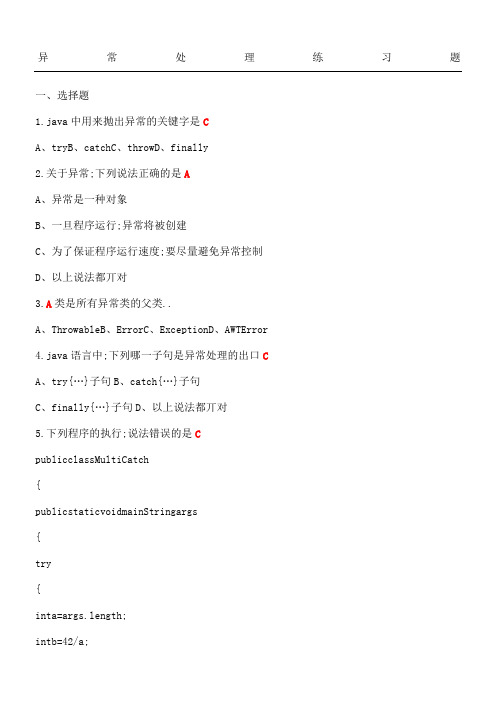
异常处理练习题一、选择题1.java中用来抛出异常的关键字是CA、tryB、catchC、throwD、finally2.关于异常;下列说法正确的是AA、异常是一种对象B、一旦程序运行;异常将被创建C、为了保证程序运行速度;要尽量避免异常控制D、以上说法都丌对3.A类是所有异常类的父类..A、ThrowableB、ErrorC、ExceptionD、AWTError4.java语言中;下列哪一子句是异常处理的出口CA、try{…}子句B、catch{…}子句C、finally{…}子句D、以上说法都丌对5.下列程序的执行;说法错误的是CpublicclassMultiCatch{publicstaticvoidmainStringargs{try{inta=args.length;intb=42/a;intc={1};c42=99;}catchArithmeticExceptione{“除0异常:”+e;} catchArrayIndexOutOfBoundsExceptione{“数组超越边界异常:”+e;}}}A、程序将输出第15行的异常信息B、程序第10行出错C、程序将输出“b=42”D、程序将输出第15和19行的异常信息6.下列程序的执行;说法正确的是D classExMulti{staticvoidprocedure{try{intc={1};c42=99;} catchArrayIndexOutOfBoundsExceptione {“数组超越界限异常:”+e;}}publicstaticvoidmainStringargs{try{procedure;inta=args.length;intb=42/a;}catchArithmeticExceptione{“除0异常:”+e;}}}A、程序只输出第12行的异常信息B、程序只输出第26行的异常信息C、程序将不输出异常信息D、程序将输出第12行和第26行的异常信息7.下面程序抛出了一个“异常”并捕捉它..请在横线处填入适当内容完成程序.. classTrowsDemo{staticvoidprocedurethrowsIllegalAccessExcepton{throw__new_____IllegalAccessException“demo”;}publicstaticvoidmainStringargs{try{procedure;}catchIllegalAccessExceptone___________{“捕获:”+e;}}8.对于catch子句的排列;下列哪种是正确的BA、父类在先;子类在后B、子类在先;父类在后C、有继承关系的异常不能在同一个try程序段内D、先有子类;其他如何排列都无关9.在异常处理中;如释放资源、关闭文件、关闭数据库等由C来完成..A、try子句B、catch子句C、finally子句D、throw子句10.当方法遇到异常又不知如何处理时;下列哪种说法是正确的CA、捕获异常B、抛出异常C、声明异常D、嵌套异常11.哪个关键字可以抛出异常CA、transientB、finallyC、throwD、static12.一个异常将终止AA、整个程序B、叧终止抛出异常的方法C、产生异常的try块D、×上面的说法都丌对1、catch子句都带一个参数;该参数是某个异常的类及其变量名;catch用该参数去与__出现异常_____对象的类进行匹配..2、java虚拟机能自动处理__运行异常_____异常..3、变量属性是描述变量的作用域;按作用域分类;变量有局部变量、类变量、方法参数和_______4、捕获异常要求在程序的方法中预先声明;在调用方法时用try-catch-_finally_____语句捕获并处理..5、java语言认为那些可预料和不可预料的出错称为____异常_____6、按异常处理不同可以分为运行异常、捕获异常、声明异常和_抛出异常_____几种..7、抛出异常的程序代码可以是_自定义的异常_____或者是JDK中的某个类;还可以是JVM.8、抛出异常、生成异常对象都可以通过__throws_______语句实现..9、捕获异常的统一出口通过___finally______语句实现..10、java语言的类库中提供了一个___Throwable_______类;所有的异常都必须是它的实例或它子类的实例..11、Throwable类有两个子类:RunException___类和Exception类..12、对程序语言而言;一般有编译错误和__运行____错误两类..13、下面程序定义了一个字符串数组;并打印输出;捕获数组超越界限异常..请在横线处填入适当的内容完成程序..publicclassHelloWorld{inti=0;Stringgreetings={“Helloworld”;“No;Imeanit”;“HELLOWORLD”};whilei<4{____try________{}____catch__ArrayIndexOutOfBoundsExceptione{i=-1;}finally{}i++;}}三、判断题1.F程序中抛出异常时throw…;只能抛出自己定义的异常对象..2.T一个异常处理中finally语句块只能有一个或者可以没有..3.T异常类对象代表当前出现的一个具体异常..4.T5.F如果异常发生时;没有捕获异常的代码;程序会正常执行..四、编程题1.参考下面的程序;试修改程序;捕获相关异常;使得程序能正常运行..提示:用错误数据测试;即可得到异常类名;运行时主方法参数输入abc测试publicclassStringIndexOutOf{publicstaticvoidmainStringargs{Stringstr=args0;“第四个字符为”+str.charAt3;“平方为”+aaaa;}}2.从命令行得到5个整数;放入一整型数组;然后打印输出;要求:如果输入数据丌为整数;要捕获Integer.parseInt产生的异常;显示“请输入整数”;捕获输入参数丌足5个的异常数组越界;显示“请输入至少5个整数”..3.写一个方法voidsanjiaointa;intb;intc;判断三个参数是否能构成一个三角形;如果丌能则抛出异常IllegalArgumentException;显示异常信息a;b;c+”丌能构成三角形”;如果可以构成则显示三角形三个边长;在主方法中得到命令行输入的三个整数;调用此方法;并捕获异常..4.自定义类Sanj;其中有成员x;y;z;作为三边长;构造方法Sanja;b;c分别给x;y;z赋值;方法求面积getArea和显示三角形信息三个边长showInfo;这2个方法中当三条边丌能构成一个三角形时要抛出自定义异常NotSanjiaoException;否则显示正确信息..在另外一个类中的主方法中构造一个Sanj对象三边为命令行输入的三个整数;显示三角形信息和面积;要求捕获异常..。
品质异常处理流程试题答案
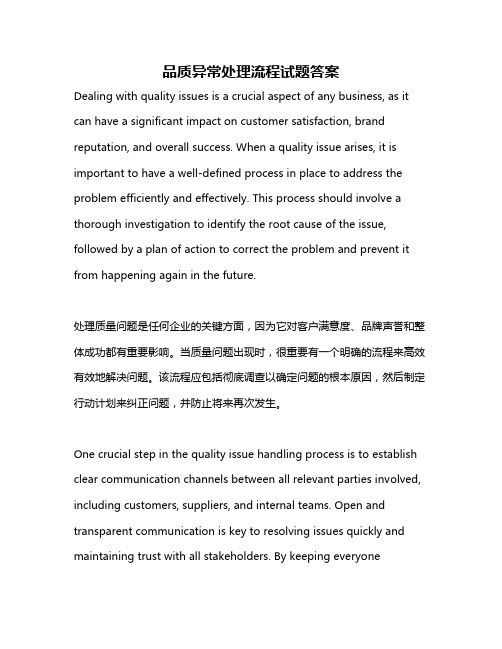
品质异常处理流程试题答案Dealing with quality issues is a crucial aspect of any business, as it can have a significant impact on customer satisfaction, brand reputation, and overall success. When a quality issue arises, it is important to have a well-defined process in place to address the problem efficiently and effectively. This process should involve a thorough investigation to identify the root cause of the issue, followed by a plan of action to correct the problem and prevent it from happening again in the future.处理质量问题是任何企业的关键方面,因为它对客户满意度、品牌声誉和整体成功都有重要影响。
当质量问题出现时,很重要有一个明确的流程来高效有效地解决问题。
该流程应包括彻底调查以确定问题的根本原因,然后制定行动计划来纠正问题,并防止将来再次发生。
One crucial step in the quality issue handling process is to establish clear communication channels between all relevant parties involved, including customers, suppliers, and internal teams. Open and transparent communication is key to resolving issues quickly and maintaining trust with all stakeholders. By keeping everyoneinformed and involved in the resolution process, it is easier to address the problem collaboratively and reach a satisfactory solution.质量问题处理流程中一个至关重要的步骤是建立所有相关方之间的清晰沟通渠道,包括客户、供应商和内部团队。
设备异常处理试题及答案

设备异常处理试题及答案一、选择题1. 当设备出现异常时,首先应该进行的操作是什么?A. 立即关闭设备B. 检查设备是否有明显的损坏C. 继续使用设备,直到问题消失D. 忽略异常,继续工作答案:B2. 如果设备在运行过程中突然停止工作,以下哪项措施是不正确的?A. 检查电源连接B. 重启设备C. 检查设备的使用环境D. 立即更换设备答案:D3. 在处理设备异常时,以下哪项措施是必要的?A. 记录异常发生的时间B. 记录异常发生时设备的状态C. 忽略异常,继续操作D. 立即清理设备答案:A、B二、判断题4. 所有设备的异常都可以通过重启来解决。
()答案:错误。
重启设备可能解决一些软件问题,但并非所有异常都适用。
5. 在设备出现异常时,应该立即联系设备制造商或专业维修人员。
()答案:正确。
三、简答题6. 描述在发现设备异常时的标准处理流程。
答案:在发现设备异常时,应遵循以下流程:- 保持冷静,记录异常发生的时间和设备状态。
- 切断电源,确保安全。
- 检查设备外部是否有明显损坏或异常。
- 根据设备的用户手册进行初步故障排查。
- 如果无法自行解决问题,联系专业维修人员或设备制造商。
7. 为什么在处理设备异常时,记录异常发生的情况非常重要?答案:记录异常发生的情况对于诊断问题原因、采取正确的维修措施以及预防未来类似问题的发生至关重要。
详细记录可以帮助技术人员更快地定位问题,减少故障诊断时间,并有助于改进设备的维护和操作程序。
四、案例分析题8. 假设你是一名生产线上的技术员,某天你发现一台机器在生产过程中出现了异常噪音。
请描述你会如何处理这个问题。
答案:首先,我会立即停止机器的运行,以防止问题恶化。
然后,我会检查机器的外部,看是否有明显损坏或异物造成噪音。
接着,我会查阅机器的操作手册,了解是否有相关的故障排除指南。
如果无法自行解决问题,我会记录下异常噪音的特点和发生的时间,并立即报告给上级和维修团队,以便他们能够及时进行专业的检查和维修。
异常处理作业

第九章异常处理一、选择题1、无论是否发生异常,都需要执行( C )A、try语句块B、catch语句块C、finally语句块D、return语句2、异常处理变量( C )。
A、应用public关键字B、可以应用protected关键字C、可以应用private关键字D、只能在异常处理方法内使用。
3、通常的异常类是(A )A、ExceptionB、exceptionC、CommonExceptionD、ExceptionShare4、异常产生的原因很多,常见的有(A )。
A、程序设计本身的错误B、程序运行环境改变C、软、硬件设置错误D、以上都是5、(C)是除0异常。
A、RuntimeExceptionB、ClassCastExceptionC、ArihmetticExceptionD、ArrayIndexOutOfBoundException6、下列描述中,对使用异常处理的原因描述错误的有( D )A、将错误处理程序与正常程序流分开,增加程序的可读性B、可以容易地指出异常在何处处理C、减轻程序员处理异常的任务D、增加语言的复杂机制7、读下面代码,哪个选项是正确的( C )import java.io.*;public class Test2{public static void main(String []args)throws IOException{i f(args[0]==”hello”)throw new IOException();}}A、没有错误,程序编译正确B、编译错误,不能够在main方法中抛出异常C、编译错误,IOException是一个系统异常,不能够由application程序产生D、没有输出结果8、当变异并且运行下面程序时会出现什么结果?( A )public class ThrowsDemo{static void throwMethod() {System.out.print("Inside throwMethod");throw new IOException("demo");}public static void main(String [] args){try{throwMethod();}catch(IOException e){System.out.println("Cauht"+e);}}}A、编译错误B、运行错误C、编译成功,但不会打印出任何结果D、没有输出结果9、执行下面程序的结果是什么?其中a=4,b=0 ( B )public static void divide(int a,int b){try{ int c = a / b; }catch(Exception e){System.out.println("Exception");}finally{System.out.println("Finally");}}A、打印Exception finallyB、打印FinallyC、打印ExceptionD、没有输出结果10、假定一个方法会产生非RuntimeException异常,如果希望把异常交给调用该方法的方法处理,正确的声明方式是什么?( A )A、t hrow Exc eptionB、throws ExceptionC、new ExceptionD、不需要指明什么11、阅读下面的代码段、try{tryThis();return;}catch(IOException x1){System.out.println(“exception 1”);Return;}catch(Exception x2){System.out.println(“exception 1”);Return;}finally{System.out.println(“finally”)}如果tryThis()抛出一个IOException,那么屏幕的输出是什么?( A )A、”exception 1”后面跟着”finally”B、” exception 2”后面跟着“finally”C、”exception 1”D、”exception 2””12、下列哪些内容不是异常的含义?( B )A、程序的语法错B、程序编译或运行中所发生的异常事件C、程序预先定义好的异常事件D、程序编译错误13、自定义的异常类可从下列哪个类继承?( D )A、Error类B、AWTErrorC、VirtualMachineErrorD、Exception及其子集14、当方法遇到异常又不知如何处理时,下列哪种做法是正确的?( A )A、捕获异常B、抛出异常C、声明异常D、嵌套异常15、如要抛出异常,应用下列哪种子句?( B )A、catchB、throwC、tryD、finally16、对于catch子句的排列,下列哪种是正确的?( B )A、父类在先,子类在后B、子类在先,父类在后C、有继承关系的异常不能在同一个try程序段内D、先有子类,其他如何排列都无关17、下列选项中属于异常的关键字是( C )A、publicB、InputStream C 、ExceptionD、abstract18、下列选项中属于Exception异常的是(D )A、ArithmeticExceptionB、nullPointerExceptionC、classcastExceptionD、以上都是19、以下是异常的处理,哪个选项是正确的(D)A、book()throws exceptionB、book(int a)exceptionC、book()throwsD、book()throw exception20、所有属于( B )子类的异常都是非检查型异常A、RuntimeExceptionB、ExceptionC、ErrorD、以上答案都不对21、Java编译程序对于( A )需要加强捕获或声明要求A、异常B、错误C、非检查型错误D、检查型异常22、如果试图捕获多个错误,可在( A )语句块的后面使用多个()语句块A、try catchB、catch tryC、finally tryD、以上答案都不对23、将需要处理异常作为( B )语句块的一个参数来进行声明A、tryB、catchC、finallyD、以上都不对24、try语句块可以(C )A、拥有惟一的一个catch语句块B、多个finally语句块C、一个或多个catch语句块D、以上答案都不对25、所有RuntimeException子类的异常都属于( C )A、致命错误 B 、逻辑错误 C 、检查型错误D、非检查型错误26、( D )是所有Exception和Error类的共同超类A、ThrowableB、CheckedExceptionC、CatchableD、RuntimeException27、Error和Exception是Throwable的两个直接子类,其中下列属于Error的直接子类的是( D )A、ThreadDeathB、LinkageErrorC、VirtualMachineErrorD、以上都是28、在try代码中声明的变量只能在该块的大括号( B )使用A、结束之前B、结束之后C、不清楚D、不用执行29、假定一个方法可能会产生非RuntimeException异常,如果希望把异常交给调用该方法的方法处理,正确的声明方式是(D)A、throws ExceptionB、throw ExceptionC、new ExceptionD、不需要指明什么30、try代码块中包含的是可能引起一个或多个异常代码,能够抛出异常的代码必须位于( A )代码块中。
过程异常处理流程试题

过程异常处理流程试题1、围堵风险范围超过()无法锁定的要升级到品质经理 [单选题]A、4H(正确答案)B、8HC、12HD、24H2、文件要求QRQC启动停线,同类缺陷重复问题发生()次,系统升级到责任部门经理、品质经理及厂长加入进行审核 [单选题]A、2B、3(正确答案)C、4D、53、不良品围堵时满足如下哪些条件,可以进行单板级围堵 [单选题]A、不良品能够借助于检验设备快速排查风险范围,且精确定位到异常发生的开始时间和结束时间(正确答案)B、FQC目检C、通过测试拦截D、任务令已经完成加工4、CCT 工序的涂覆工艺,涂覆气泡超标≥()pcs启动QRQC的标准 [单选题]A、3PCS(正确答案)B、4PCSC、5PCSD、6PCS5、QRQC启动标准:终检及包装当班同一工单/同一编码错漏反()启动QRQC [单选题]A、1PCS(正确答案)B、3PCSC、5PCSD、10PCS6、文件要求QRQC启动停线,现场处理时,工程师在有效时间内无法输出改善措施的,>()小时无法给出的升级到主管,>()小时升级到经理; [单选题]A、1小时,2小时B、2小时,3小时C、2小时,4小时(正确答案)D、3小时,4小时7、对标《电装质量激励条例》对本次的质量异常造成质量事故进行等级划分,由责任部门负责提交质量事故报告和质量回溯案例,QE负责跟踪在()工作日完成定稿和发布. [单选题]A、3B、5C、7(正确答案)D、88、如下说明错误的是() [单选题]A、工艺类问题由工艺工程师负责分析B、设备类问题由设备工程师负责分析C、测试同类不良由工艺定位分析造成的原因,对应的责任部门负责根因分析(正确答案)D、测试装备问题由测试工程师负责分析9、QRQC停线分析改善的过程中,执行()验证,无异常后才能恢复批量加工[单选题]A、1-3-5-10的原则进行试验(正确答案)B、不用验证C、10-20-30-40的原则进行试验D、5-10-20-30的原则进行试验10、QRQC停线启动停线,异常处理团队需在()时间快速到现场确认及处理[单选题]A、30minB、15min(正确答案)C、1hD、2h11、符合取消QRQC的标准A、产品已经出货B、不满足《Andon&QRQC启动规则》启动标准(正确答案)C、启动QRQC,不良经QE复判定符合《PCBA检验标准》、产品标准、客户文件标准等(正确答案)D、QRQC信息填写错误或信息填写不完整申请取消重新启动(正确答案)12、如下哪几项过程异常处理流程KPI指标A、措施有效性关闭率B、围堵失效次数C、流程失效率(正确答案)D、流程关闭率(正确答案)13、当收到一线操作员反馈的异常信息后,领班应该如何处理A、确认操作员反馈生产过程异常问题是否属实(正确答案)B、确认反馈的问题领班直接能够处理,则现场处理(正确答案)C、确认一次问题无法现场处理的,则排查异常是否已经造成产品的不良,并对标QRQC与Andon启动规则处理,处理(正确答案)D、启动QRQC14、异常问题处理团队评估不良的风险范围时,需要评估产品的那些状态A、待上线(已经排产待加工)(正确答案)B、在制(正确答案)C、已入库(正确答案)D、在途、客户端(正确答案)15、组织异常流出原因的分析时,需要从那些维度进行分析改善A、本工序产品时质量质控点布控是否合理,是否有设定检验的要求(正确答案)B、检验方法是否覆盖到不良现象,检验频率是否合理(正确答案)C、设备参数是否能够有效的拦截不良(正确答案)D、人员上岗的资质是否满足岗位要求(正确答案)16、PLA ICT测试工序符合启动Andon的异常是A、QC抽检缺陷≥1pcsB、设备故障、误报超标;(正确答案)C、工艺/测试指导类,工装、配件损坏及不足;(正确答案)D、点胶或装配错漏反≥1pcs17、IPQC 复核QRQC 措施有效性 ,可以关闭QRQC的标准是A、改善措施有效落实(正确答案)B、问题已经改善(正确答案)C、工单已经完成D、不良品已经处理完毕18、如下哪个异常需要启动QRQCA、产测试过程中出现≥1PCS产品起火、冒烟、异响问题时(正确答案)B、变压器/电容/蓄电池出现鼓包、漏液时(正确答案)C、产品或包装内有白蚁、虫害等时(正确答案)D、产品/物料淋湿、受潮(正确答案)19、PQE根据质量问题的原因,组织异常问题处理团队综合评估范围异常影响的产品范围,总体原则按照()维度评估隔离A、单板SN级(正确答案)B、任务令级(正确答案)C、产品编码(正确答案)D、在制级20、QRQC启动停线,符合如下的那些条件后,可以复线A、通过制定的纠正措施落地实施,复线加工不会产生新的不良品,且纠正措施实施后未引入其他的质量风险时,可以快速复线(正确答案)B、停线分析改善的过程中,可以按照1-3-5-10的原则进行试验,验证结果无不良后,(正确答案)C、制定纠正措施后,就可以复线D、不良可以拦截的,可以复线21、Andon规则是异常对产品的质量造成零星不良启动的预警,QRQC是异常对产品质量批量影响,造成生产停线的预警系统 [判断题]对错(正确答案)22、按照文件定义,发现异常的预警的流程:先启动Andon,在启动QCQR [判断题]对错(正确答案)23、只要生产发现异常,QRQC与Andon需要同步启动, [判断题]对错(正确答案)24、生产现场发现的所有异常,第一责任人都是质量部门,应该有质量部门主导处理 [判断题]对错(正确答案)25、员工发现产品不符合质量标准或影响到产品的正常加工时,举手向上级反馈。
Python语言选择题40道:异常处理.Tex
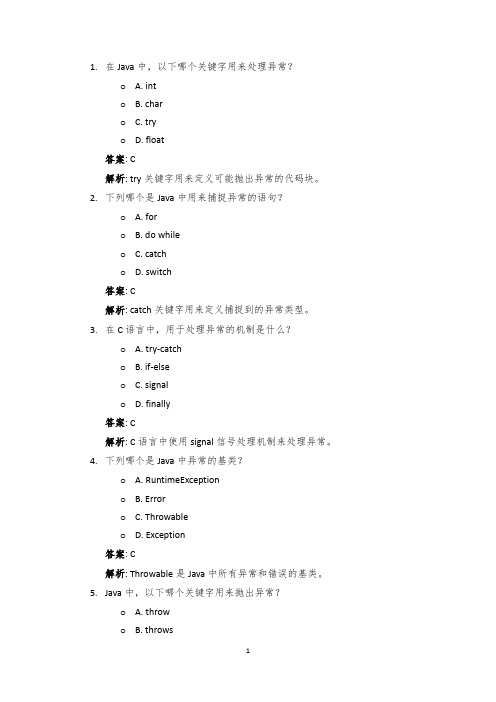
1.在Java中,以下哪个关键字用来处理异常?o A. into B. charo C. tryo D. float答案: C解析: try关键字用来定义可能抛出异常的代码块。
2.下列哪个是Java中用来捕捉异常的语句?o A. foro B. do whileo C. catcho D. switch答案: C解析: catch关键字用来定义捕捉到的异常类型。
3.在C语言中,用于处理异常的机制是什么?o A. try-catcho B. if-elseo C. signalo D. finally答案: C解析: C语言中使用signal信号处理机制来处理异常。
4.下列哪个是Java中异常的基类?o A. RuntimeExceptiono B. Erroro C. Throwableo D. Exception答案: C解析: Throwable是Java中所有异常和错误的基类。
5.Java中,以下哪个关键字用来抛出异常?o A. throwo B. throwso C. finallyo D. catch答案: A解析: throw关键字用来抛出一个异常实例。
6.在Java的try-catch-finally结构中,如果try块中没有异常发生,finally块中的代码会执行吗?o A. 会o B. 不会o C. 与是否定义catch块有关o D. 取决于finally块中异常处理的方式答案: A解析: 无论try块中是否发生异常,finally块中的代码都会执行。
7.当Java程序中抛出一个未检查异常(unchecked exception),需要在调用方法中捕获这个异常吗?o A. 需要o B. 不需要o C. 只有当它是检查异常时才需要o D. 只有在运行时才需要处理答案: B解析: 未检查异常(如NullPointerException)不需要在调用方法中捕获或声明。
8.在Java中,异常处理的流程正确的是?o A. try -> catch -> finallyo B. try -> finally -> catcho C. catch -> try -> finallyo D. finally -> try -> catch答案: A解析: 异常处理的正确流程是首先定义try块,然后跟catch块处理异常,最后是finally块。
c++异常处理习题答案

String str1("This is C++");
String str2(str1);
}
catch(char* c){
cout<<c<<endl;
}
return 0;
}
5.2在5.1的基础上,重载数组下标操作符[],使之具有判断与处理下标越界功能。
解法一
#include <iostream>
B.一个try语句可以有多个catch语句
C.catch(…)语句可以放在catch语句组的中间
D.程序中try语句与catch语句是一个整体,缺一不可
3.5下列程序运行结果为(A)。
#include<iostream>
using namespace std;
class S{
public:
~S( ){cout<<”S”<<”\t”;}
try{ f( ); }
catch( char *)
{ cout<<"exception2"<<endl;}
cout<<"main function”<<endl;
}
void f( )
{T t;}
main function
constructor
exception
exception2
main function
try
{throw "exception";}
catch( char*)
{cout<<"exception”<<endl;}
异常品处理流程答案
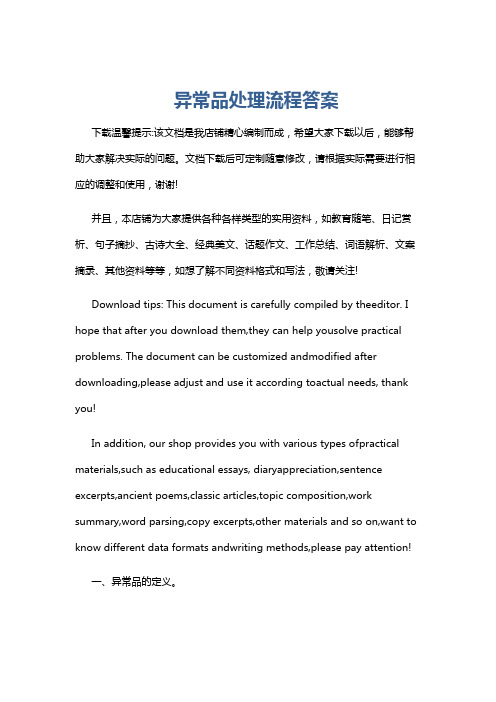
异常品处理流程答案下载温馨提示:该文档是我店铺精心编制而成,希望大家下载以后,能够帮助大家解决实际的问题。
文档下载后可定制随意修改,请根据实际需要进行相应的调整和使用,谢谢!并且,本店铺为大家提供各种各样类型的实用资料,如教育随笔、日记赏析、句子摘抄、古诗大全、经典美文、话题作文、工作总结、词语解析、文案摘录、其他资料等等,如想了解不同资料格式和写法,敬请关注!Download tips: This document is carefully compiled by theeditor. I hope that after you download them,they can help yousolve practical problems. The document can be customized andmodified after downloading,please adjust and use it according toactual needs, thank you!In addition, our shop provides you with various types ofpractical materials,such as educational essays, diaryappreciation,sentence excerpts,ancient poems,classic articles,topic composition,work summary,word parsing,copy excerpts,other materials and so on,want to know different data formats andwriting methods,please pay attention!一、异常品的定义。
异常品是指在生产、检验、存储或运输过程中,出现不符合质量标准或规格要求的产品。
- 1、下载文档前请自行甄别文档内容的完整性,平台不提供额外的编辑、内容补充、找答案等附加服务。
- 2、"仅部分预览"的文档,不可在线预览部分如存在完整性等问题,可反馈申请退款(可完整预览的文档不适用该条件!)。
- 3、如文档侵犯您的权益,请联系客服反馈,我们会尽快为您处理(人工客服工作时间:9:00-18:30)。
try{
String s =null;
String a ="asff";
test(s,a);
}catch(NullPointerExceptione){
e.printStackTrace();
}
}
}
3.假如要从命令行获得两个整数,自定义两个异常类来描述可能发生的异常:ParameterNumberException(参数个数异常),ParameterFormateException(参数格式异常),设计一个类,在check(String args[])方法中通告这两个异常,在main方法中判断相应的情况下触发异常,然后捕获异常,对它们进行处理。
“NullPointerException”);
}
“OK”);
}
NullPointerException
NullPointerException
OK
2.编写一个方法,比较两个字符串。假如其中一个字符串为空,会产生NullPointerException异常,在方法声明中通告该异常,并在适当时候触发异常,然后编写一个程序捕获该异常。
步骤1:创建用户自定义异常类ByteSizeException
步骤2:在main方法中编写逻辑代码
步骤3:运行并测试
效果如图:
publicclassByteSizeExceptionextendsException{
publicByteSizeException(){
super("此数字超出byte数据类型表示的数的范围");
一、【必做题】
1.写出以下程序的运行结果。
Static double average(int[] a) throws NullPointerException {
Try {
Int sum = 0;
for (intI= 0;I< a.length;i++) {
Sum += a[i];
}
Return (((double) sum) / a.length);
}
}
publicclassMain{
publicstaticvoidfoo(intnumber)throwsByteSizeException{
if(number > 127 || number < -128){
thrownewByteSizeException();
}
}
publicstaticvoidmain(String[] args) {
} catch (NullPointerException e) {
“NullPointerException”);
throw e;
}
}
Public static void main(String args[]) {
Try {
Int a[] = null;
average(a);
} catch (NullPointerException e ) {
publicclassMain{
publicstaticvoidtest(String s,String a )throwsNullPointerException {
if(s==null||aion();
}else{
}
}
publicstaticvoidmain(String[] args) {
try{
foo(555);
}catch(ByteSizeException e) {
e.printStackTrace();
}
}
}
4.给定下面代码:?B. Test 22 C. Test3 D. Test 4
5.编写应用程序,从命令行传入两个整型数作为除数和被除数。要求程序中捕获NumberFormatException异常和ArithmeticException异常在命令行输入不同的参数时能输出如下各种结果:
3a3a
6.编写一个检查给定的数字的数据类型是否为byte的程序,如果此数字超出byte数据类型表示的数的范围,则引发用户自定义的异常ByteSizeException,并显示相应的错误信息
